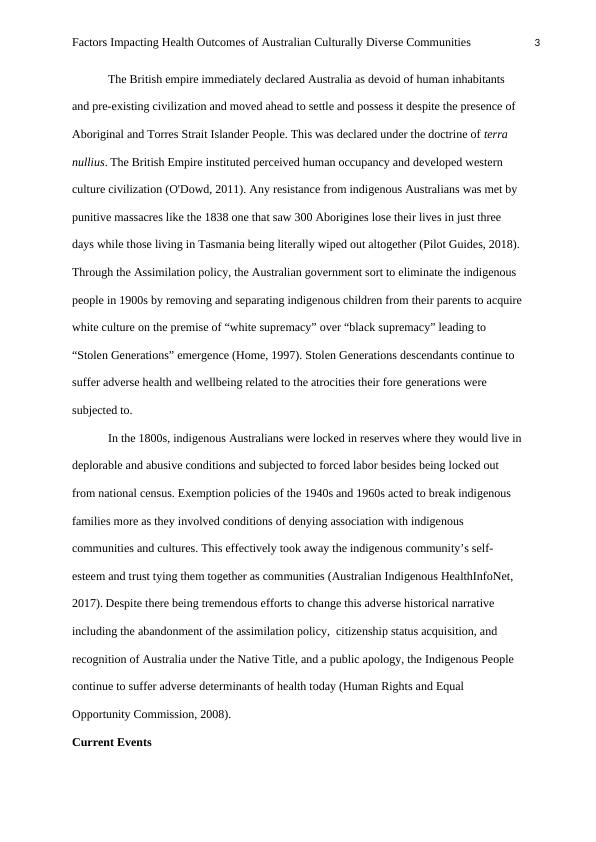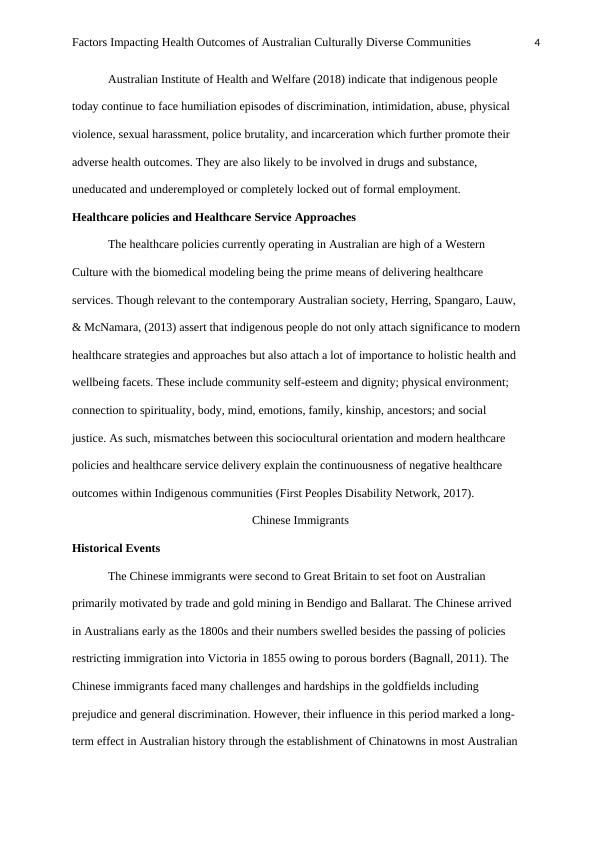Factors Impacting Health Outcomes of Australian Culturally Diverse Communities
Added on 2023-06-04
12 Pages3064 Words377 Views
Running Head: Factors Impacting Health Outcomes of Australian Culturally Diverse
Communities 1
Factors Impacting Health Outcomes of Australian Culturally Diverse Communities
Name
Institution
Date
Communities 1
Factors Impacting Health Outcomes of Australian Culturally Diverse Communities
Name
Institution
Date

Factors Impacting Health Outcomes of Australian Culturally Diverse Communities 2
Factors Impacting Health Outcomes of Australian Culturally Diverse Communities
Introduction
Health and well-being disparities have characterized Australian communities for a
long time now with the members of the Aboriginal and Torres Strait Islander People
contending with the most adverse healthcare outcomes (Australian Human Rights
Commission, 2007). Indeed, the United Nations have since dared to label these disparities a
human rights issue in Australia and the Australian federal, state and territorial governments
accepting it as such (Dudgeon, et al., 2010). A great deal of historical and current social
determinants of health, as well as existing health care policies and services, explain the
emergence and progress of this situation. Against this backdrop, this paper will endeavor to
extrapolate though comparison the historical and current events as well as healthcare policies
and service provision impacting health risks factors and/or influencing health and wellbeing
outcomes of two diverse Australian groups: Indigenous Australians and Chinese Immigrants.
Aboriginal and Torres Strait Islander People
Historical Events
The plight of Aboriginal and Torres Strait Islander People relating to their continuous
adverse health and wellbeing outcomes dates back to the colonial period when the British
Empire first set foot on the Australian soil in 1788 (McBain‐Rigg, & Veitch, 2011). These
indigenous groups who were then and still significantly are hunters and gatherers were
pushed from their ancestral homes to remote regions of Australia by the British colonizers.
These remote regions where most indigenous Australians still reside today have been left
behind both socially and economically creating an ample platform for long-term health and
wellbeing plight (Commonwealth of Australia, 2013). Moreover, due to their perceived
timidity and cultural orientation, these people have further been subjected to more suffering
as they are stereotypically seen to be primitive and backward (Waterworth, et al., 2015).
Factors Impacting Health Outcomes of Australian Culturally Diverse Communities
Introduction
Health and well-being disparities have characterized Australian communities for a
long time now with the members of the Aboriginal and Torres Strait Islander People
contending with the most adverse healthcare outcomes (Australian Human Rights
Commission, 2007). Indeed, the United Nations have since dared to label these disparities a
human rights issue in Australia and the Australian federal, state and territorial governments
accepting it as such (Dudgeon, et al., 2010). A great deal of historical and current social
determinants of health, as well as existing health care policies and services, explain the
emergence and progress of this situation. Against this backdrop, this paper will endeavor to
extrapolate though comparison the historical and current events as well as healthcare policies
and service provision impacting health risks factors and/or influencing health and wellbeing
outcomes of two diverse Australian groups: Indigenous Australians and Chinese Immigrants.
Aboriginal and Torres Strait Islander People
Historical Events
The plight of Aboriginal and Torres Strait Islander People relating to their continuous
adverse health and wellbeing outcomes dates back to the colonial period when the British
Empire first set foot on the Australian soil in 1788 (McBain‐Rigg, & Veitch, 2011). These
indigenous groups who were then and still significantly are hunters and gatherers were
pushed from their ancestral homes to remote regions of Australia by the British colonizers.
These remote regions where most indigenous Australians still reside today have been left
behind both socially and economically creating an ample platform for long-term health and
wellbeing plight (Commonwealth of Australia, 2013). Moreover, due to their perceived
timidity and cultural orientation, these people have further been subjected to more suffering
as they are stereotypically seen to be primitive and backward (Waterworth, et al., 2015).

Factors Impacting Health Outcomes of Australian Culturally Diverse Communities 3
The British empire immediately declared Australia as devoid of human inhabitants
and pre-existing civilization and moved ahead to settle and possess it despite the presence of
Aboriginal and Torres Strait Islander People. This was declared under the doctrine of terra
nullius. The British Empire instituted perceived human occupancy and developed western
culture civilization (O'Dowd, 2011). Any resistance from indigenous Australians was met by
punitive massacres like the 1838 one that saw 300 Aborigines lose their lives in just three
days while those living in Tasmania being literally wiped out altogether (Pilot Guides, 2018).
Through the Assimilation policy, the Australian government sort to eliminate the indigenous
people in 1900s by removing and separating indigenous children from their parents to acquire
white culture on the premise of “white supremacy” over “black supremacy” leading to
“Stolen Generations” emergence (Home, 1997). Stolen Generations descendants continue to
suffer adverse health and wellbeing related to the atrocities their fore generations were
subjected to.
In the 1800s, indigenous Australians were locked in reserves where they would live in
deplorable and abusive conditions and subjected to forced labor besides being locked out
from national census. Exemption policies of the 1940s and 1960s acted to break indigenous
families more as they involved conditions of denying association with indigenous
communities and cultures. This effectively took away the indigenous community’s self-
esteem and trust tying them together as communities (Australian Indigenous HealthInfoNet,
2017). Despite there being tremendous efforts to change this adverse historical narrative
including the abandonment of the assimilation policy, citizenship status acquisition, and
recognition of Australia under the Native Title, and a public apology, the Indigenous People
continue to suffer adverse determinants of health today (Human Rights and Equal
Opportunity Commission, 2008).
Current Events
The British empire immediately declared Australia as devoid of human inhabitants
and pre-existing civilization and moved ahead to settle and possess it despite the presence of
Aboriginal and Torres Strait Islander People. This was declared under the doctrine of terra
nullius. The British Empire instituted perceived human occupancy and developed western
culture civilization (O'Dowd, 2011). Any resistance from indigenous Australians was met by
punitive massacres like the 1838 one that saw 300 Aborigines lose their lives in just three
days while those living in Tasmania being literally wiped out altogether (Pilot Guides, 2018).
Through the Assimilation policy, the Australian government sort to eliminate the indigenous
people in 1900s by removing and separating indigenous children from their parents to acquire
white culture on the premise of “white supremacy” over “black supremacy” leading to
“Stolen Generations” emergence (Home, 1997). Stolen Generations descendants continue to
suffer adverse health and wellbeing related to the atrocities their fore generations were
subjected to.
In the 1800s, indigenous Australians were locked in reserves where they would live in
deplorable and abusive conditions and subjected to forced labor besides being locked out
from national census. Exemption policies of the 1940s and 1960s acted to break indigenous
families more as they involved conditions of denying association with indigenous
communities and cultures. This effectively took away the indigenous community’s self-
esteem and trust tying them together as communities (Australian Indigenous HealthInfoNet,
2017). Despite there being tremendous efforts to change this adverse historical narrative
including the abandonment of the assimilation policy, citizenship status acquisition, and
recognition of Australia under the Native Title, and a public apology, the Indigenous People
continue to suffer adverse determinants of health today (Human Rights and Equal
Opportunity Commission, 2008).
Current Events

Factors Impacting Health Outcomes of Australian Culturally Diverse Communities 4
Australian Institute of Health and Welfare (2018) indicate that indigenous people
today continue to face humiliation episodes of discrimination, intimidation, abuse, physical
violence, sexual harassment, police brutality, and incarceration which further promote their
adverse health outcomes. They are also likely to be involved in drugs and substance,
uneducated and underemployed or completely locked out of formal employment.
Healthcare policies and Healthcare Service Approaches
The healthcare policies currently operating in Australian are high of a Western
Culture with the biomedical modeling being the prime means of delivering healthcare
services. Though relevant to the contemporary Australian society, Herring, Spangaro, Lauw,
& McNamara, (2013) assert that indigenous people do not only attach significance to modern
healthcare strategies and approaches but also attach a lot of importance to holistic health and
wellbeing facets. These include community self-esteem and dignity; physical environment;
connection to spirituality, body, mind, emotions, family, kinship, ancestors; and social
justice. As such, mismatches between this sociocultural orientation and modern healthcare
policies and healthcare service delivery explain the continuousness of negative healthcare
outcomes within Indigenous communities (First Peoples Disability Network, 2017).
Chinese Immigrants
Historical Events
The Chinese immigrants were second to Great Britain to set foot on Australian
primarily motivated by trade and gold mining in Bendigo and Ballarat. The Chinese arrived
in Australians early as the 1800s and their numbers swelled besides the passing of policies
restricting immigration into Victoria in 1855 owing to porous borders (Bagnall, 2011). The
Chinese immigrants faced many challenges and hardships in the goldfields including
prejudice and general discrimination. However, their influence in this period marked a long-
term effect in Australian history through the establishment of Chinatowns in most Australian
Australian Institute of Health and Welfare (2018) indicate that indigenous people
today continue to face humiliation episodes of discrimination, intimidation, abuse, physical
violence, sexual harassment, police brutality, and incarceration which further promote their
adverse health outcomes. They are also likely to be involved in drugs and substance,
uneducated and underemployed or completely locked out of formal employment.
Healthcare policies and Healthcare Service Approaches
The healthcare policies currently operating in Australian are high of a Western
Culture with the biomedical modeling being the prime means of delivering healthcare
services. Though relevant to the contemporary Australian society, Herring, Spangaro, Lauw,
& McNamara, (2013) assert that indigenous people do not only attach significance to modern
healthcare strategies and approaches but also attach a lot of importance to holistic health and
wellbeing facets. These include community self-esteem and dignity; physical environment;
connection to spirituality, body, mind, emotions, family, kinship, ancestors; and social
justice. As such, mismatches between this sociocultural orientation and modern healthcare
policies and healthcare service delivery explain the continuousness of negative healthcare
outcomes within Indigenous communities (First Peoples Disability Network, 2017).
Chinese Immigrants
Historical Events
The Chinese immigrants were second to Great Britain to set foot on Australian
primarily motivated by trade and gold mining in Bendigo and Ballarat. The Chinese arrived
in Australians early as the 1800s and their numbers swelled besides the passing of policies
restricting immigration into Victoria in 1855 owing to porous borders (Bagnall, 2011). The
Chinese immigrants faced many challenges and hardships in the goldfields including
prejudice and general discrimination. However, their influence in this period marked a long-
term effect in Australian history through the establishment of Chinatowns in most Australian

End of preview
Want to access all the pages? Upload your documents or become a member.
Related Documents
Media’s Influence on the Health and Wellbeing of Aboriginal and Torres Strait Islander Peoplelg...
|19
|3252
|258
Contemporary Indigenous Health and Wellbeinglg...
|8
|1920
|496
Comparing Groups: Aboriginal and Torres Strait Islander People and LGBT Community in Australialg...
|10
|2837
|448
Comparing group assignment PDFlg...
|10
|2813
|110
Health Inequalities Between Aboriginal and Non-Indigenous Populationslg...
|6
|1262
|17
Promote Aboriginal and Torres Islander Strait Cultural Safetylg...
|14
|1221
|26
